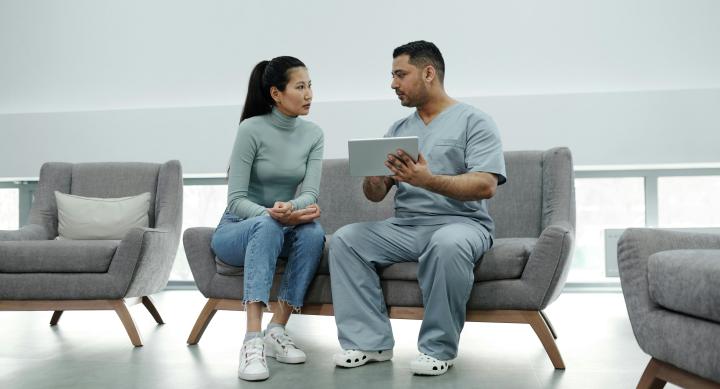
Life-Threatening Emergency: Challenging: Discussion with Family/ Beloved Ones
November 2022
The Center for Health Communication Think Tank, an initiative of Dell Medical School and Moody College of Communication's joint Center for Health Communication, provides free 1-hour health communication consulting with an interdisciplinary collective of experts to equip healthcare providers with practical communication strategies and tools they can implement into their daily work immediately.
Our September client champions were Dr. Emily Hirsch and her colleague Dr. Christy Keyes, Emergency Medicine physicians at Prisma Health in the upstate part of South Carolina. This report summarizes the result of discussions with Drs. Hirsch and Keyes, the video Deep Dive meeting, and pre-and post-meeting work by the Center for Health Communication Think Tank.
The conundrum
How do we talk to patients and family members about advanced care plans and end-of-life wishes in the midst of a pressing, life-threatening emergency?
Background
Rapid advanced care plan discussions were commonplace at the height of the Covid 19 pandemic. People came in breathless, and a decision needed to be made regarding life support or comfort care. Drs. Hirsch and Keyes are looking for strategies that facilitate a rapid care planning conversation with the patient and loved ones when there is a need for rapid discernment or affirmation of the patient’s values and preferences. Sometimes the patient can participate, but often they are in too much distress.
If the family is feeling frightened or guilty they may make decisions that run counter to what matters most to the patient. They may regret decisions if they feel as though the communication was unclear. People may feel responsible for the decision as if the person living or dying was up to them. People may withdraw from participation because they feel morally implicated. An efficient, quality advanced care plan discussion in the Emergency Department is a key part of a comfortable and dignified death.
Highlights from the deep dive discussion
The goal is kindness and limiting guilt
| Takeaways | Recommendations | Implementation/Examples |
|---|---|---|
Set the stage, draw them in | Name the stress Gain participation Draw them in | "We need to have a challenging conversation...I invite you to take a deep breath with me before we start." "We're at a decision point" "I want you to join us in these decisions we are about to make" |
Validate stress and guilt | Name the burden Validate stress and guilt Place emphasis on the emotional/guilt/relationship/comfort part rather than the rational or teaching part | "It's never easy..." |
Sensing when we have trust | In the absence of trust, it's more difficult to make the difficult decision to provide supportive treatment Check-in directly when you feel that trust may not be present or is not confirmed | If you wonder if you may have lost trust, consider a noticing statement: "You're not sure about this." "I hope I have your trust." |
Specific communication tactics
| Takeaways | Recommendations | Implementation/Examples |
|---|---|---|
Rapid motivational interviewing | Guiding statements that elicit a focus on the patient's values | "__ is very, very sick." "Have y'all had discussions about how __ wants to die?" "We may be at that moment now." |
Set the stage | Be honest about the urgency of the situation Let them know a brief conversation and an important decision are coming | "We're going to take 4 minutes, get an update on your loved one, and then we're going to make a decision." |
Give the big picture | An update focusing on one critical piece followed by one big-picture statement | "The infection is making it very difficult for __ to breathe. We can help make choices for __ that are consistent with their wishes." |
No wrong answer | Frame the decision with a statement that "there are no wrong choices" Followed by a "we" statement establishing confidence in the decision | "There are no wrong choices. We will find a choice that's right for __." |
Framed as a collective decision on behalf of the patient | Offer direction, framed as a collective moving forward | "We invite you..." "Based on what I now know, I might recommend..." |
Provide specific recommendations | A choice that provides a better understanding of what will happen. Agency. Something for them to respond to and reflect on | "If we do this then __, and if we do this then __." |
Dialogue closure | Close conversation with agreement and promise that this is just the start of the conversation/relationship | "Give us a moment to do our work, and I'll come back to you and we can continue to talk it through." |
Guiding statements
| Takeaways | Recommendations | Implementation/Examples |
|---|---|---|
When the decision seems discordant with the patient's wishes | Use "I hope" and "I worry" Or "I wish," "I wonder," and "I worry" | "I hope that if we can protect their airway, they will have enough support to come back to us. I worry that they are so weak that this may not be the right thing for them and won't bring them back. I think that..." "I wish your mother wasn't so seriously ill" "I worry she is actively dying, and that using a breathing tube and ventilator machine may cause increased suffering without meaningfully improving her health." "I wonder if a natural death, in which we focus on your mother's dignity and aggressively tend to comfort is in line with her wishes and values." |
Afterward
| Takeaway | Recommendations | Implementation/Examples |
|---|---|---|
Take an interest in improving | Ask the family afterward | "What worked and what could have been better?" |

